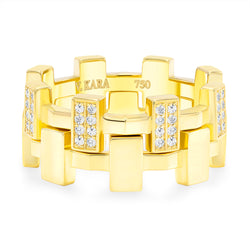On June 2, 2025, the Gemological Institute of America (GIA) announced a sweeping change that will reshape how the jewelry world evaluates lab-grown diamonds. Rather than grading these stones with the same color and clarity terminology used for natural diamonds, GIA will now assign lab-grown diamonds to two quality categories: Premium or Standard.
It’s a defining moment. And naturally, it raises a question we hear often:
“Will this affect the value of natural diamonds?”
Let’s explore.
What Changed: A New Framework for Lab-Grown Quality
Historically, GIA used the same color (D-Z) and clarity (IF to I3) grading scale for both natural and lab-grown diamonds. That decision helped legitimize lab-created stones in the eyes of many consumers.
But now, in a clear attempt to create more distinction between natural and man-made stones, GIA has announced it will:
-
Discontinue the use of traditional color and clarity grading for lab-grown diamonds.
-
Introduce two simplified quality tiers:
-
Premium: Higher overall quality (color, clarity, and finish)
-
Standard: Acceptable quality but not top-tier
-
-
Exclude any lab-grown diamond that fails to meet baseline quality from receiving a designation at all.
In other words: not all lab-grown diamonds will be graded, and those that are will receive a broader classification—not the precise grades many buyers have grown used to.
Why GIA Made This Change
GIA’s move serves two purposes:
-
Clarity – Simplifying the grading system for consumers, many of whom find traditional diamond nomenclature confusing.
-
Reinforcement of Differentiation – Reasserting that natural diamonds remain the benchmark for rarity, prestige, and legacy.
It’s also a quiet way to help the natural diamond industry re-establish its position amid rising lab-grown sales.
So… Will This Affect Natural Diamond Prices?
In the short term, not dramatically. But in the long term, this update does support price stability—and even value preservation—for natural diamonds. Here’s why:
1. Perceived Value Gap Just Widened
By no longer using the exact same grading system for lab-grown stones, GIA is reinforcing that natural and lab-grown diamonds are fundamentally different categories—not interchangeable goods.
This distinction helps protect the perceived prestige and long-term value of natural diamonds, especially in engagement rings and heirloom pieces.
2. High-End Buyers May Shift Back to Natural
Some clients who previously leaned toward high-quality lab-grown stones (especially those seeking D/IF perfection) may now feel less confident in lab-grown purchasing—especially without exact grades. This may reignite demand for investment-grade natural diamonds.
3. Market Segmentation Will Increase
This move will likely create a more defined split:
-
Lab-grown diamonds dominate in entry-level and fashion jewelry.
-
Natural diamonds retain dominance in legacy, bridal, and investment categories—especially in sizes above 1.5 carats, with strong provenance.
What This Means for You
If you already own natural diamonds:
This change subtly strengthens their resale and legacy value. The language of rarity is once again on your side.
If you’re considering a purchase:
Lab-grown diamonds remain a beautiful, modern choice—especially for those seeking size and sparkle at a lower price point. But if you’re purchasing with long-term value or heirloom intentions in mind, natural diamonds just became a little more reassuring.
At Vardui Kara, we work with both—because the best choice is the one that reflects your values, story, and intention. Whether lab-grown or mined, every diamond we offer is hand-selected, GIA-certified, and set in fine gold—crafted to live forever.
Final Thoughts
GIA’s decision is more than an industry footnote—it’s a signal of where the diamond world is headed. As distinctions sharpen and narratives evolve, we remain focused on what matters most: helping you make jewelry choices with clarity, confidence, and meaning.
Explore our lab diamond collection—including both natural and lab-grown diamonds, each designed to become your signature piece.



Leave a comment